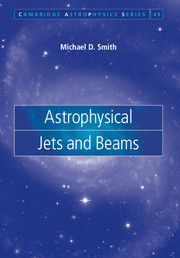Book contents
- Frontmatter
- Contents
- Preface
- 1 Introduction
- 2 Detection and measurement
- 3 The dynamical toolbox
- 4 Observations of extragalactic jets
- 5 Jets in galactic nuclei
- 6 Jets from young stars and protostars
- 7 Jets associated with evolved stars
- 8 Jets within the solar system
- 9 Jet launching
- 10 Jet propagation
- 11 The astrophysical jet
- References
- Index
1 - Introduction
Published online by Cambridge University Press: 05 March 2012
- Frontmatter
- Contents
- Preface
- 1 Introduction
- 2 Detection and measurement
- 3 The dynamical toolbox
- 4 Observations of extragalactic jets
- 5 Jets in galactic nuclei
- 6 Jets from young stars and protostars
- 7 Jets associated with evolved stars
- 8 Jets within the solar system
- 9 Jet launching
- 10 Jet propagation
- 11 The astrophysical jet
- References
- Index
Summary
Rudimentary definitions and concepts
A man-made jet is a narrow stream forced out of a designed aperture or nozzle. Water fountains and jet engines provide everyday examples of liquid and gas jets. Skin penetration and rock drilling are high-technology applications. Jets also occur naturally on the Earth associated with geysers and some types of volcanic eruption. These terrestrial jets arise when material is raised to a high pressure below the surface and is forced to ascend through channels with rigid walls. In contrast, the astrophysical jet involves relatively unfamiliar physics, usually under extreme, but occasionally in exotic, conditions.
In astronomy, there is rarely a solid nozzle or tube to align the jet flow. The material is driven, with a few exceptions, through an interacting gas. In other words, an astrophysical jet is a slender channel of high-speed gas propagating through a gaseous environment. The exceptional jets are the nearest extraterrestrial jets associated with comets such as Hale-Bopp. In the latter case, as for those shown in Fig. 1.1, they are believed to form when a high-pressure mixture of gas and dust breaks through vents in a solid crust.
Astrophysical jets are driven from diverse objects on very different size and mass scales. They can be produced from the vicinity of supermassive black holes in the case of active galactic nuclei (AGN), by star-sized black holes in microquasars, by neutron stars in some X-ray binaries, by protostellar cores in young stellar objects, and by white dwarfs in symbiotic binaries and supersoft X-ray sources.
- Type
- Chapter
- Information
- Astrophysical Jets and Beams , pp. 1 - 15Publisher: Cambridge University PressPrint publication year: 2012

